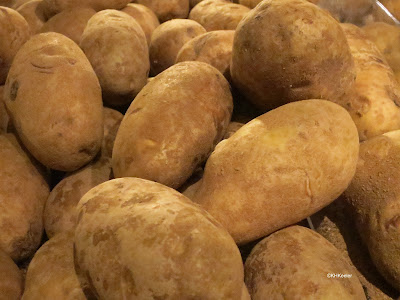One peculiar characteristic of plants, not much shared by animals, is polyploidy, multiple copies of all the chromosomes. In plants and animals, DNA, the genetic material, is bound up in protein-wrapped bodies called chromosomes. Organisms have several to many chromosomes, usually as pairs. For animals, each species has a characteristic number--humans 23 pairs, dogs 39 pairs--with very little variation. One of the ways that plants are DIFFERENT is that chromosome number can vary a lot, between species but also between plants of the same species growing next to each other.
 |
carrots, flowering
|
Sometimes variation in chromosome number is small, plus or minus one chromosome in a group of 20, for example (called aneuploidy, by the way). But often it is more dramatic. Common carrots (
Daucus carota) have 18 chromosomes, but
Daucus glochidiatus, a carrot native to Australia, has 44 chromosomes, more than twice as many. The apple,
Malus domestica, has 34 chromosomes but some varieties have 68 as does the related species, Siebold's crabapple,
Malus sieboldii. Within fireweeds (
Chamerion angustifolium) and buffalo grass (
Buchloë dactyloides) plants with two copies of the genome grow next to individuals with four copies. These are exampls of doubling of all the chromosomes, from two copies in each cell's nucleus, to four copies, within and between species.
To talk about this variation, botanists use the term ploidy, polyploidy being the collective term for all the variation. Polyloidy is the duplication of all genes at once, so also called whole genome duplication (WGD). I'll use the traditional botanical terms. The number of copies of a chromosome in a cell is its ploidy level. Most cells have two copies and are diploid. Gametes (sex cells) with only one copy are haploid. The Australian carrot and Siebold's crabapple have 4 copies and are tetraploid. Bread wheat is hexaploid, sugar cane octoploid. (You can avoid the difficult words by saying 4x, 6x, and 8x for diploidy, tetraploidy, and hexaploidy respectively, x meaning "times the basic number of chromosomes.") I made a table of the terms. The higher forms are rarer but not unheard of (I found duodecaploids in a brome grass Bromus, a guava (Psidium) and a blue-eyed grass (Sisyrinchium) on a very quick search). Polyploidy is very strange from an animal point-of-view, while it is common and diverse in plants.

Recent estimates suggest that there is a polyploid event, a doubling of all the chromosomes, in the evolutionary history of all higher plants, and frequently several such doublings. Deep evolutionary studies are finding whole genome duplication in the ancestry of other organisms as well, but I will focus on plants.
Here are examples of familiar plants that are polyploids: white potatoes (Solanum tuberosum) 4x, common wheat (Triticum aestivum) 6x, sugarcane (Saccharum officinarum) 8x, bananas (Musa paradisiaca) 3x, sweet potato (Ipomoea batatas) 4x and 6x, coffee (Coffea arabica) 4x, alfalfa (Medicago sativa) 4x, cotton (Gossypium tomentosum) 4x, (4x), tobacco (4x), Kentucky bluegrass (Poa pratensis 3x-8x), tall fescue (Lolium arundinaceum) 6x, buffalo grass (Buchloë dactyloides) 2x,4x,and 6x, dandelion (Taraxacum officinale) 3x, ragweed (Ambrosia psilostachya) 2x-16x, blanket flower (Gaillardia x grandiflora) 4x, pineapple (Ananas comosus) 4x, many grape varieties (Vitus) varieties are 4x, commercial strawberries (Fragaria x ananassa) 8x, yarrow (Achillea millefolium) 6x), fireweed (Chamerion angustifolium) 2x and 4x, the list goes on and on.
 |
bread wheat, Triticum aestivum, an allopolyploid hexaploid (6x)
|
Compared to diploids (2x), polyploids are often bigger because more chromosomes in the nucleus require bigger nuclei and bigger cells. Uneven ploidy levels (3x, 5x, 7x) tend to be sterile because the pollen and ovules get uneven numbers of chromosomes. And inheritance is likely radically changed, for example: instead of the offspring getting either a1 or a2 from an a1a2 parent, in a tetraploid (4x) they will get either a1a2 or a1a1, or a2a2 from an a1a1a2a2 the parent--the four chromosomes carrying that gene are distributed at random. In other polyploids, the four copies of the same chromosome may act as two pairs and neatly produce a1a2 and a'1a'2. Certainly, adding one or more copies of the genes gives a plant a lot of new variation on which evolution can work; for example, instead of having two copies of a gene for drought tolerance, there are now four. That may be an imporant bottom line on polyploidy: it adds variation that is potentially adaptive.
 |
| potatoes, Solanum tuberosum, tetraploid (4x) and autopolyploid |
Familiar plants that are diploid, breeding like the nice examples in humans we all learned in school, include peas (Pisum sativuum), tomatoes (Solanum lycopersicon), common sunflower (Helianthus annuus), corn (Zea mays), soybeans (Glycine max), watermelon (Citrullus lanatus), rice (Oryza sativa), broccoli and cabbage (Brassica oleracea), radishes (Raphanus sativus) and lettuce (Lactuca sativa). Of course there are more.
 |
Part of a plant cell, stained to show the chromosomes
|
Since polyploidy has complex implications, it can be hard to work with. Plant breeders found ways not to have to cross polyploids. That is one reason why potatoes and bananas are largely cloned. Throughout my career (1970-2006) researchers worked around polyploidy whenever possible--like, studied only diploids--because of the ways it complicated analysis. But there are so many important plants that are polyploid, they couldn't avoid them indefinitely.
How do polyploids form? This general picture has been known for a century. Some are produced by hybridization between species (allopolyploidy). For example, bread wheat is the result of the hybridization of three different species, each doubling all its chromosomes in the hybrid. Doubling the chromosomes of a hybrid creates stability since each chromosome now has a mate to pair with at cell division. Allopolyploidy often leads to new species because the hybrid is not able to cross with its diploid relatives. Other polyploids are produced when the existing chromosomes of a plant double. The cultivated--white--potato, Solanum tuberosum, is an example of this with 4 copies of each of its ancestral chromosomes, no other species involved. This is called autopolyploidy and its causes are not well-understood.
 |
Gaillardia x grandiflora, allopolyploid tetraploid (4x)
|
One of the strengths of current plant science is the ability to study many polyploid plants, sampling small amounts of tissue in nature and analyzing those for ploidy. Before about 1990, determining ploidy meant counting chromosomes under a microscope, a slow process requiring a skilled technician. Today there are several different approaches for determining ploidy (once you've done controls with microscope slides), mapped genomes provide genetic insight into many plant lineages, big computers will handle complex calculations so that small differences can be detected against the background variation of weather and climate...and so on. The questions remain difficult but are yielding.
I will talk about these in future posts. For my Ph.D. thesis, I picked a plant in which to compare genetic variation within and between temporary pools, assuming blithely that it was a diploid. Wrong. Veronica peregrina, purslane speedwell, is a hexaploid (6x). I filled notebooks with drawings of what I would expect in crosses between different individuals. (That was the early 1970s, personal computers did not exist). So I've been aware that polyploidy lurks "out there" for a long time. Polyploidy is perhaps just as difficult in crosses as it was then, but, oh, the tools to look at it are so much better.
 | speedwell, Veronica, very like V. peregrina
(alas my photos from 50 years ago have faded horribly). |
|
| It is worth sometimes pointing out that plants are not just little green animals. They have some quite alien characteristics. |
|
In sum, polyploidy, duplication of all the chromosomes, is very widespread in plants. It has complex consequences. The genetics, physiology, and evolutionary implications of polyploidy will be considered in future posts.
Comments and corrections welcome.
References
Hadle, J. J., F. L. Russell, and J. B. Beck. 2019. Are buffalograss (Buchloë dactyloides) cytotypes spatially and ecologically differentiated? American Journal of Botany 106(8): 1116–1125. (OK, buffalo grass has more ploidy levels than just diploid and tetraploid, but does have those.)
Höfer, M. and A. Meister. 2010. Genome Size Variation in Malus Species. Journal of Botany. Volume 2010, Article ID 480873, 8 pages link (Accessed 2/15/24)
Husband, B.C. and D. W. Schemske. 2000. Ecological mechanisms of reproductive isolation between diploid and tetraploid Chamerion angustifolium. Journal of Ecology. 88 (4): 689-701.
Muenchrath, D., A. Campbell, L. Merrick, T. Lübberstedt, and S.-Z. Fei. Chapter 10. Ploidy, Polyploidy, Aneuploidy, and Haploidy. Crop Genetics. Iowa State University. link (Accessed 2/15/24)
Soltis, D.E., C. J. Visger, and P. S. Soltis. 2014. The polyploidy revolution, then...and now. Stebbins revisited. American Journal of Botany. 101 (7): 1057-1078.
Van de Peer, Y. E. Mizrachi, and K. Marchal. 2017. The evolutionary significance of polyploidy. Nature Reviews Genetics. 18: 411-424.
Kathy Keeler, A Wandering Botanist







No comments:
Post a Comment